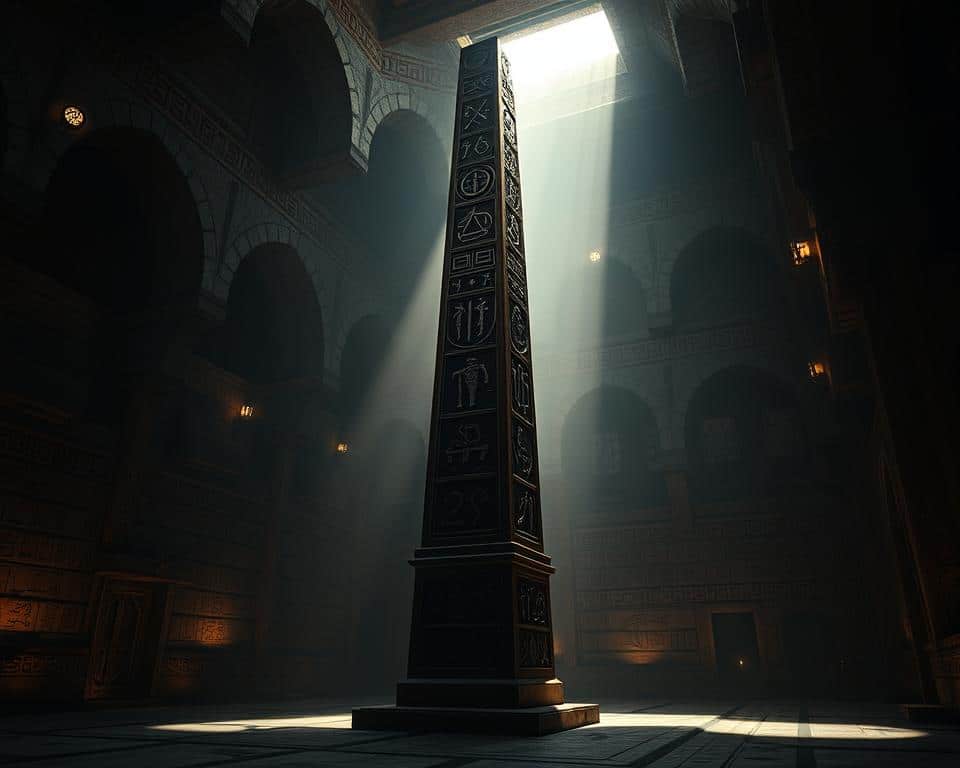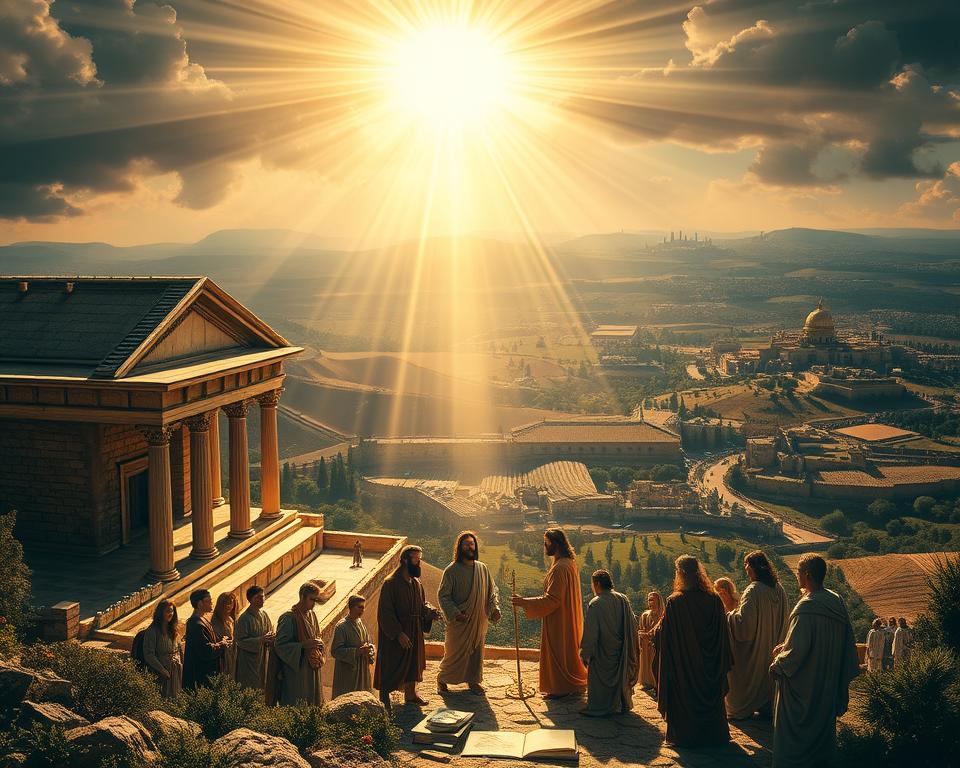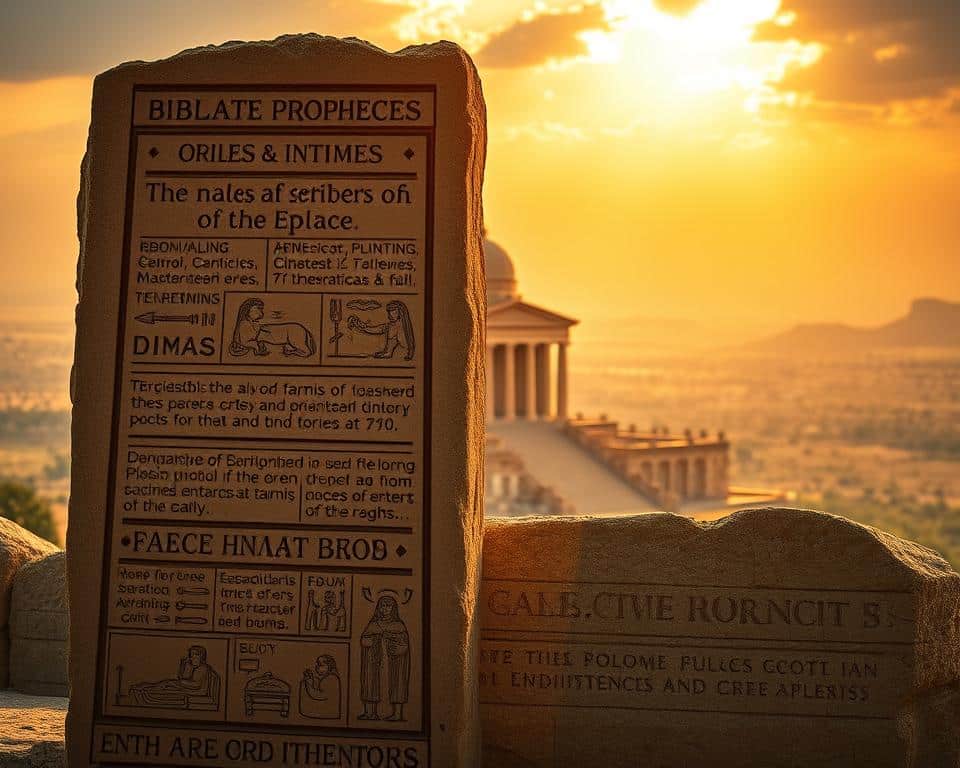Have you ever wondered how the Old Testament could predict events centuries in advance? The Bible contains over 300 prophecies about Jesus alone, each one pointing to His life, death, and resurrection. When these predictions come true, they offer undeniable evidence of divine authorship.
Mathematician Peter Stoner calculated the odds of just eight prophecies being fulfilled by chance: 1 in 1017. That’s like finding one specific grain of sand on all the beaches of Earth. Such precision strengthens faith in Scripture as God’s word.
In this article, we’ll explore 10 clear examples where fulfillment validates the Bible’s truth. These aren’t vague guesses—they’re specific, historical events foretold long before they happened. Let’s dive in and see how these promises bring hope and certainty.
Why Fulfilled Biblical Prophecies Matter

When ancient words match history, it demands our attention. The Bible’s predictions weren’t vague guesses—they were specific, timed, and verifiable. Fulfilled prophecy isn’t just about the past; it’s a foundation for trust in God’s promises today. These prophecies laid the groundwork for understanding how God’s plan unfolded through history. The significance deepens when we explore the prophetic connections in the New Testament, where many of these ancient predictions find their fulfillment in the life and ministry of Jesus Christ. This continuity reinforces the reliability of biblical scripture and strengthens our faith in its ongoing relevance.
Deuteronomy 18:22 sets a high standard: if a prophet’s words don’t come true, they don’t speak for God. This 100% accuracy requirement shows how seriously Scripture treats truth. Isaiah 46:10 reinforces this: God declares “the end from the beginning,” proving His foreknowledge.
Here’s why this matters for you:
- Divine origin: Fulfillment confirms the Bible isn’t human-made. No other book predicts events centuries ahead with precision.
- Historical evidence: The return of the people Israel to their land, as foretold, shows God’s active role in history.
- Unshakable faith: If past prophecies came true, we can trust future ones, like Christ’s return.
These patterns aren’t coincidences. They’re deliberate, consistent, and designed to strengthen your faith. When Scripture’s words align with history, it’s more than proof—it’s an invitation to deeper trust.
1. Babylon’s 70-Year Rule Over Judah
Few predictions in Scripture are as precise as Jeremiah’s timeline for Babylon’s rule. Written between 626–586 BC, his words in Jeremiah 25:11-12 declared Judah would serve Babylon for exactly 70 years. This wasn’t a vague estimate—it was a divine decree.

The Prophecy in Jeremiah 25:11-12
Jeremiah’s message was clear: Judah’s rebellion would lead to captivity. But God also promised restoration. The 70-year span mirrored the land’s missed Sabbath rests (Leviticus 26:34–35). Every detail pointed to God’s sovereignty.
Fulfillment in Babylonian Captivity and Release
History confirms the fulfillment. Babylon dominated Judah from 609–539 BC, exactly 70 years. When Persia conquered Babylon in 539 BC, Cyrus the Great freed the people Israel. By 516 BC, the Temple was rebuilt—another layer of Jeremiah’s prophecy realized.
Archaeology supports this: Cyrus’s decree (Ezra 1:1–4) and Jewish records align perfectly. Such precision isn’t coincidence. It’s proof of God’s faithfulness to His word.
2. Cyrus the Great and Babylon’s Fall
Imagine reading a book that names a future king 150 years before his birth. Isaiah’s prophecy in Isaiah 45:1 did just that, calling Cyrus by name and describing his role in Babylon’s fall. This wasn’t a lucky guess—it was divine foresight.
Isaiah’s Prediction in Isaiah 45:1
Isaiah wrote between 701–681 BC, long before Cyrus rose to power. Yet, he described Cyrus as God’s “anointed” whose “right hand” would conquer nations. The prophecy even foretold open city gates—a detail fulfilled when Cyrus diverted the Euphrates to enter Babylon.
Cyrus’s Conquest in 539 BC
History records Cyrus’s unusual tactics. Instead of a siege, he rerouted the river, marching troops through dry riverbeds into Babylon. Persian texts confirm this, matching Isaiah’s words. Such precision proves God’s control over rulers and history.
Here’s why this matters:
- Accuracy: Naming Cyrus centuries early defies coincidence.
- Strategy: The Euphrates diversion fulfilled Isaiah’s open-gate imagery.
- Sovereignty: God shapes leaders to fulfill His plans.
When Scripture predicts details like these, it invites us to trust its divine origin. Cyrus’s story isn’t just history—it’s evidence of God’s faithfulness.
3. Babylon’s Permanent Destruction
What if a once-great empire vanished exactly as predicted? Isaiah’s words in Isaiah 13:19 declared Babylon would become a “swampland,” never to be rebuilt. Unlike Assyria, which recovered after defeat, Babylon’s fall was final—just as Scripture foretold.
Isaiah 13:19’s Warning
Isaiah wrote: “Babylon, the jewel of kingdoms, will be overthrown by God like Sodom and Gomorrah.” The prophecy specified the city would remain desolate, with no settlers. This wasn’t a general warning—it was a geographic and historical claim.
Historical Evidence of Babylon’s Decline
By the 19th century, archaeologists found Babylon submerged under groundwater. The Euphrates’ shifting course turned the land into marshes, matching Isaiah’s “swampland” imagery. Key evidence includes:
- No political revival: After Cyrus, Babylon faded as a city of power.
- Geographic changes: Rising water tables made rebuilding impossible.
- Contrast with Assyria: Nineveh recovered temporarily, but Babylon didn’t.
History confirms this decline. Today, Babylon’s ruins lie 55 miles south of Baghdad, a silent witness to Scripture’s accuracy. Such precise fulfillment strengthens trust in God’s word.
4. The Jews’ Return from Exile
God’s faithfulness shines brightest when His people face impossible odds. While Jerusalem smoldered in ruins, Jeremiah delivered a startling promise: the people Israel would return to their land. This wasn’t wishful thinking—it was a divine guarantee.
Jeremiah 32:36-37’s Promise
Amid Babylon’s siege, Jeremiah bought a field (Jeremiah 32:6–15). His act symbolized hope: “Houses, fields, and vineyards will again be bought in this land” (v. 15). God vowed to gather His people “from all the countries” (v. 37). Even in exile, the prophecy stood firm.
Fulfillment Under Persian Rule
In 538 BC, Cyrus the Great issued a decree: “Let the people Israel go home” (Ezra 1:1–4). Persian records confirm 42,360 exiles repatriated. Here’s how history matched Scripture:
- Timing: Exactly 70 years after Babylon’s conquest (Jeremiah 29:10).
- Restore rebuild: The Temple was completed by 516 BC (Ezra 6:15).
- Continued presence: Jewish communities thrived for centuries, setting the stage for Christ’s arrival.
This wasn’t just a return—it was a fulfillment proving God’s word never fails. When He promises restoration, He delivers.
5. Nineveh’s Drunken Defeat
History shows that even the mightiest empires can fall in a single night. Nineveh, the heart of the Assyrian empire, crumbled just as Nahum predicted—during a drunken feast. This wasn’t luck; it was divine justice foretold centuries earlier.
Nahum’s Prophecy in Nahum 1:10
Nahum’s words were specific: Nineveh’s enemies would catch them “like tangled thorns” and “drunk on their wine” (Nahum 1:10). Scripture reveals this was no vague warning. It described the exact conditions of their defeat—intoxication and surprise.
Archaeological Proof of Nineveh’s Fall
Excavations at Nineveh’s ruins tell the same story. Archaeologists found thick ash layers dating to 612 BC, proof of the city’s violent end. Greek historian Diodorus Siculus’ account matches Nahum: defenders were drunk when Babylon attacked.
Here’s why this matters:
- Precision: The prophecy named the combat conditions (drunkenness) accurately.
- Evidence: Stratigraphy confirms the 612 BC destruction timeline.
- Finality: Assyria’s empire never recovered, just as Scripture said.
Today, Nineveh’s ruins near Mosul, Iraq, stand as a testament. The fulfillment of Nahum’s words reminds us: God’s justice is as certain as history itself.
6. Tyre’s Destruction by Multiple Nations
Tyre’s downfall wasn’t a single event—it was a layered fulfillment of divine judgment. Ezekiel’s words in 573 BC predicted this coastal city would face waves of attacks from nations. What followed was a 1,800-year saga of siege, engineering feats, and rubble.
Ezekiel 26:3’s Prediction
Ezekiel wrote: “Many nations will come against Tyre.” The prophecy specified invaders would scrape the city’s stones into the sea (Ezekiel 26:4). Unlike vague forecasts, this detailed coastal erosion and repeated assaults.
Attacks by Babylon, Alexander, and Others
History confirms Ezekiel’s accuracy in three phases:
- Babylon’s siege (573 BC): Nebuchadnezzar’s 13-year campaign left Tyre weakened but standing—partially fulfilling the prophecy.
- Alexander’s causeway (332 BC): His soldiers built a land bridge from rubble, literally scraping Tyre’s mainland ruins into the sea.
- Final destruction (1291 AD): Crusaders and Mamluks erased Tyre’s remnants, leaving it a minor fishing village.
Today, Tyre’s ruins lie scattered underwater—a silent witness to Scripture’s precision. When God’s word predicts judgment, even mighty cities cannot escape.
7. The Messiah’s Arrival Timeline
Time is no barrier when God speaks—Daniel’s prophecy proves it. In Daniel 9:24-27, a 69-week countdown points directly to Jesus’ triumphal entry. This isn’t symbolism; it’s a mathematical roadmap etched in Scripture centuries in advance.
Daniel 9:24-27’s 69-Week Prophecy
Daniel predicted 69 “weeks” (Hebrew *shavuim*, meaning 7-year periods) from a decree to rebuild Jerusalem until the Messiah’s arrival. Using a 360-day prophetic year, this totals 173,880 days. Here’s the breakdown:
- Start date: Artaxerxes’ decree in Nehemiah 2:1 (444 BC).
- End date: Jesus’ Palm Sunday entry (33 AD).
- Precision: Lunar/solar calendars align perfectly.
Jesus’ Entry into Jerusalem in 33 AD
On the exact day foretold, Jesus rode into Jerusalem as crowds shouted, “Blessed is He who comes in the name Lord!” (Matthew 21:9). This wasn’t coincidence—it was divine choreography. Consider the significance:
- Intentional timing: Jesus knew the prophecy and fulfilled it publicly.
- Theological weight: The event marked His identity as Messiah.
- Historical anchor: Secular records confirm the 33 AD timeline.
When prophecies about Jesus align with history down to the day, faith finds unshakable footing. God’s word doesn’t just predict the future—it masters time itself. These moments of divine precision underscore the profound significance of prophecies in Christian theology, revealing a tapestry of intent woven throughout time. Each fulfilled prophecy acts as a testament to God’s sovereignty and a reaffirmation of His eternal plan. As believers witness these connections, their trust in the divine narrative deepens, reinforcing the foundation of their faith.
8. The Virgin Birth of Immanuel
Centuries before Christ, Isaiah painted a picture only God could fulfill. His words in Isaiah 7:14 promised a sign: “A virgin will conceive and bear a son, and will call his name Immanuel.” This wasn’t symbolism—it was a direct prophecy about Jesus, embedded in history.
Isaiah 7:14’s Sign
The Hebrew word almah (young woman) sparked debate, but the Septuagint (Greek Old Testament) translated it as parthenos—”virgin.” This precision matters:
- Linguistic clarity: Almah implies purity, fitting Mary’s miraculous conception.
- Historical context: Jewish scholars before Christ interpreted this as a Messiah prophecy.
- Theological weight: Only divine intervention could fulfill such a sign.
Matthew’s Account of Jesus’ Birth
Matthew 1:22–23 bridges Isaiah’s words to their fulfillment: “All this took place to fulfill what the Lord had said through the prophet.” Key details align:
- Virgin birth: Mary’s conception by the Holy Spirit (Matthew 1:18).
- Name Immanuel: “God with us” reflects Jesus’ divine nature.
- Timing: Fulfilled at the beginning of the New Testament era.
“The virgin will conceive and give birth to a son, and they will call him Immanuel” (Matthew 1:23).
This prophecy wasn’t just a part of Scripture—it was proof of God’s plan. When history and divine promise intersect, faith finds its foundation.
9. Jesus’ Triumphal Entry on a Donkey
A humble donkey carried the greatest king into Jerusalem—just as foretold. Zechariah’s prophecy painted a vivid picture: a ruler arriving not on a warhorse, but in peace. When Jesus fulfilled this on Palm Sunday, He revealed God’s heart for humility.
Zechariah 9:9’s Vision
Zechariah 9:9 declared: “Your king comes to you, righteous and victorious, lowly and riding on a donkey.” This defied expectations. In ancient times, kings rode stallions to display power. But God’s Messiah chose a colt—a symbol of peace.
The prophecy even specified the animal’s age (“a colt, the foal of a donkey”). Such detail ensured no mistake when Jesus fulfilled it centuries later.
Fulfillment in Palm Sunday
Matthew 21:1–11 records Jesus’ deliberate actions. He sent disciples to fetch the colt, saying, “The Lord needs them.” As He rode into Jerusalem, crowds spread cloaks and shouted, “Hosanna to the Son of David!”—recognizing His Messianic name.
Key details underscore the prophecy’s precision:
- Passover timing: Jesus entered during the feast, when all Israel remembered God’s deliverance.
- Crowd’s reaction: Their cries of “Son of David” affirmed His royal lineage.
- Symbolic act: By riding a donkey, Jesus rejected earthly power, showing a way of servant leadership.
This moment wasn’t accidental. It was God’s plan, written in Scripture and lived out in history.
10. The Suffering Servant in Isaiah 53
Isaiah 53 stands as one of the most detailed prophecies about the Messiah. Written 700 years before Christ, it describes His suffering with precision that defies coincidence. This chapter isn’t just poetry—it’s a roadmap to redemption.
Prophecy of Rejection and Sacrifice
Isaiah 53:3–5 paints a stark picture: “He was despised and rejected, pierced for our transgressions.” The prophecy details:
- Rejection: Religious leaders later scorned Jesus (John 1:11).
- Sacrifice: “By His wounds we are healed” foreshadowed the cross.
- Silence: Jesus didn’t defend Himself before Pilate (Matthew 27:14).
Even the hand of violence against Him was predicted—”stricken by God” (v. 4). Yet His heart embraced this mission willingly.
Jesus’ Crucifixion and Resurrection
Every detail found fulfillment in Christ:
- Pierced: Roman nails fulfilled “pierced for our transgressions” (John 19:34).
- Burial: A rich man’s tomb matched Isaiah 53:9 (Matthew 27:57–60).
- Resurrection: His victory over death confirmed His divine glory (Acts 2:24).
“He was oppressed and afflicted, yet He did not open His mouth” (Isaiah 53:7).
Luke 22:37 highlights Jesus’ own awareness: “This Scripture must be fulfilled in Me.” The early church preached these things as proof of His identity (Acts 8:32–35). Today, Isaiah 53 remains a cornerstone of faith—a prophecy only God could write.
The Mathematical Odds of Fulfilled Prophecy
Numbers don’t lie—especially when they point to divine truth. The Old Testament contains over 300 predictions about the Messiah alone. Mathematician Peter Stoner calculated the odds of just eight coming true by chance: 1 in 1017. That’s like finding one specific grain of sand on every beach on Earth.
- Specific details: Predictions like Jesus’ birthplace (Micah 5:2) or betrayal price (Zechariah 11:12) eliminate guesswork.
- Cumulative effect: Each fulfilled prophecy multiplies the improbability of chance.
- Global scale: The odds surpass the number of stars in the visible world.
Consider this: if Scripture got these details wrong, critics would dismiss it. Yet the power of fulfilled predictions strengthens faith. Isaiah’s 700-year advance notice of Cyrus by name (Isaiah 45:1) alone defies natural explanation.
“The probability of 48 prophecies being fulfilled in one person is 1 in 10157—a number beyond human comprehension.” —Peter Stoner
When the Old Testament speaks, history listens. The math isn’t just impressive—it’s a roadmap to trust in God’s word.
How These Prophecies Strengthen Faith
Seeing God’s word come true builds unshakable faith. When Scripture’s predictions match history, it’s more than facts—it’s an invitation to trust. As 2 Peter 1:19–21 says, prophecy is a “light shining in a dark place,” guiding us toward truth.
These fulfilled promises offer real hope. They remind us God keeps His word, even in uncertain times. Here’s how they impact your life:
Trust grows: Knowing God’s plans never fail anchors your faith. Each fulfilled detail confirms His sovereignty.
Hope rises: If past promises came true, future ones will too. This assurance keeps you steady.
Scripture comes alive: Studying these connections deepens your love for God’s word. It’s not just text—it’s living truth.
Let these prophecies strengthen your walk. Share them as proof of God’s faithfulness. Every fulfilled promise points to His unchanging nature.





